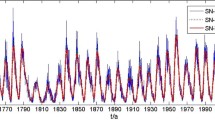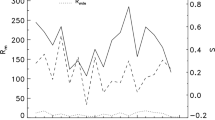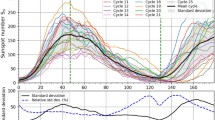Abstract
A novel approach to forecast the ongoing solar cycle, Cycle 25, is proposed in this article. The new (Version 2.0) of the smoothed monthly sunspot number is well fitted by our four-parameter function, with a mean correlation coefficient of \(\overline{r} = 0.984 \) for all the past cycles. This function can be simplified into different reduced functions, which are more suitable for making predictions. The free parameters of these reduced functions are either \(B\), the key parameter, as it is linked to the amplitude, or both \(B\) and \(\alpha \) (the parameter linked to the rising time). Three predictions are made. First, relying on the available data (i.e., 25 months) from the sunspot series, we use a two-parameter function to estimate the peak value to be \(A = 172 \pm 18\) SSN (sunspot number) around \(2024.7 \pm 0.7\) year. Then, we propose a new model as the foundation of the other two forecasts. A new three-parameter function is introduced to fit the \(B\)-parameters of the previous cycles and forecast the ongoing ones. The predictive power of our two functions is added to make two more predictions about the peak of Cycle 25; one that considers the available data (\(A = 147 \pm 27\) SSN around \(2024.6 \pm 0.7\) year) and another that does not (\(A = 156 \pm 31\) SSN around \(2024.3 \pm 0.7\) year). By taking the crossing of the confidence intervals, we estimate Cycle 25 to reach its peak \(A = 164 \pm 10\) SSN around \(2024.5 \pm 0.7 \) year.









Similar content being viewed by others
Data Availability
The data used in this study are downloaded from the Sunspot Index and Long-term Solar Observations website (https://www.sidc.be/silso/datafiles).
References
Bhowmik, P., Nandy, D.: 2018, Prediction of the strength and timing of sunspot cycle 25 reveal decadal-scale space environmental conditions. Nat. Commun. 9, 5209. DOI.
Carrington, R.C.: 1859, Description of a singular appearance seen in the Sun on September 1, 1859. Mon. Not. Roy. Astron. Soc. 20, 13.
Choudhuri, A.R., Chatterjee, P., Jiang, J.: 2007, Predicting solar cycle 24 with a solar dynamo model. Phys. Rev. Lett. 98, 131103. DOI.
Clette, F., Svalgaard, L., Vaquero, J.M., Cliver, E.W.: 2014, Revisiting the sunspot number. Space Sci. Rev. 186, 35. DOI.
Clette, F., Lefèvre, L.: 2016, The new sunspot number: assembling all corrections. Solar Phys. 291, 2629. DOI.
De Meyer, F.: 1998, Modulation of the solar magnetic cycle. Solar Phys. 181, 201. DOI.
Dikpati, M., Charbonneau, P.: 1999, A Babcock-Leighton flux transport dynamo with solar-like differential rotation. Astrophys. J. 518, 508. DOI.
Dikpati, M., De Toma, G., Gilman, P.A.: 2006, Predicting the strength of solar cycle 24 using a flux-transport dynamo-based tool. Geophys. Res. Lett. 33. DOI.
Du, Z.L.: 2022, The solar cycle: a modified Gaussian function for fitting the shape of the solar cycle and predicting cycle 25. Astrophys. Space Sci. 367, 1. DOI.
Du, Z.L., Wang, H.N.: 2011, The prediction method of similar cycles. Res. Astron. Astrophys. 11, 1482. DOI.
Fye, F.K., Cleaveland, M.K.: 2001, Paleoclimatic analyses of tree-ring reconstructed summer drought in the United States, 1700-1978. Tree-Ring Res. 57, 31.
Han, Y.B., Yin, Z.Q.: 2019, A decline phase modeling for the prediction of solar cycle 25. Solar Phys. 294, 1. DOI.
Hathaway, D.H.: 2015, The solar cycle. Living Rev. Solar Phys. 12, 1. DOI.
Hathaway, D.H., Upton, L.A.: 2016, Predicting the amplitude and hemispheric asymmetry of solar cycle 25 with surface flux transport. J. Geophys. Res. Space Phys. 121, 10. DOI.
Hathaway, D.H., Wilson, R.M., Reichmann, E.J.: 1994, The shape of the sunspot cycle. Solar Phys. 151, 177. DOI.
Hazra, G., Choudhuri, A.R.: 2019, A new formula for predicting solar cycles. Astrophys. J. 880, 113. DOI.
Ihaka, R., Gentleman, R.: 1996, R: a language for data analysis and graphics. J. Comput. Graph. Stat. 5(3), 299.
Iijima, H., Hotta, H., Imada, S., Kusano, K., Shiota, D.: 2017, Improvement of solar-cycle prediction: plateau of solar axial dipole moment. Astron. Astrophys. 607, L2. DOI.
Jiang, J., Chatterjee, P., Choudhuri, A.R.: 2007, Solar activity forecast with a dynamo model. Mon. Not. Roy. Astron. Soc. 381, 1527. DOI.
Kane, R.P.: 2007, A preliminary estimate of the size of the coming solar cycle 24, based on Ohl’s precursor method. Solar Phys. 243, 205. DOI.
Kakad, B., Kumar, R., Kakad, A.: 2020, Randomness in sunspot number: a clue to predict solar cycle 25. Solar Phys. 295, 1. DOI.
Ku, H.H.: 1966, Notes on the use of propagation of error formulas. J. Res. Natl. Bur. Stand. 70, 263.
Li, F.Y., Xiang, N.B., Kong, D.F., Xie, J.L.: 2017, The shape of solar cycles described by a simplified binary mixture of Gaussian functions. Astrophys. J. 834, 192. DOI.
Li, F.Y., Kong, D.F., Xie, J.L., Xiang, N.B., Xu, J.C.: 2018, Solar cycle characteristics and their application in the prediction of cycle 25. J. Atmos. Sol.-Terr. Phys. 181, 110. DOI.
Lu, J.Y., Xiong, Y.T., Zhao, K., Wang, M., Li, J.Y., Peng, G.S., Sun, M.: 2022, A novel bimodal forecasting model for Solar Cycle 25. Astrophys. J. 924, 59. DOI.
McIntosh, S.W., Chapman, S., Leamon, R.J., Egeland, R., Watkins, N.W.: 2020, Overlapping magnetic activity cycles and the sunspot number: forecasting sunspot cycle 25 amplitude. Solar Phys. 295, 1. DOI.
Nandy, D.: 2021, Progress in solar cycle predictions: sunspot cycles 24 – 25 in perspective. Solar Phys. 296, 54. DOI.
Ohl, A.I.: 1966, Wolf’s number prediction for the maximum of the cycle 20. Soln. Dannye 12, 84.
Okoh, D.I., Seemala, G.K., Rabiu, A.B., Uwamahoro, J., Habarulema, J.B., Aggarwal, M.: 2018, A Hybrid Regression-Neural Network (HR-NN) method for forecasting the solar activity. Space Weather 16, 1424. DOI.
Pesnell, W.D.: 2012, Solar cycle predictions (invited review). Solar Phys. 281, 507. DOI.
Pesnell, P.W.D., Schatten, K.H.: 2018, An early prediction of the amplitude of solar cycle 25. Solar Phys. 293, 1. DOI.
Petrovay, K.: 2010, Solar cycle prediction. Living Rev. Solar Phys. 7, 1. DOI.
Petrovay, K.: 2020, Solar cycle prediction. Living Rev. Solar Phys. 17, 1. DOI.
Pishkalo, M.I.: 2008, Preliminary prediction of solar cycles 24 and 25 based on the correlation between cycle parameters. Kinemat. Phys. Celest+ 24, 242. DOI.
Sarp, V., Kilcik, A., Yurchyshyn, V., Rozelot, J.P., Ozguc, A.: 2018, Prediction of solar cycle 25: a non-linear approach. Mon. Not. Roy. Astron. Soc. 481, 2981. DOI.
Schatten, K., Myers, D.J., Sofia, S.: 1996, Solar activity forecast for solar cycle 23. Geophys. Res. Lett. 23, 605. DOI.
Schwabe, H.: 1843, Solar observations during 1843. Astron. Nachr. 20, 495.
Kakad, B., Kakad, A., Ramesh, D.S.: 2017, Shannon entropy-based prediction of solar cycle 25. Solar Phys. 292, 1. DOI.
Kitiashvili, I.N.: 2020, Application of synoptic magnetograms to global solar activity forecast. Astrophys. J. 890, 36. DOI.
Vaquero, J.M., García, J.A., Gallego, M.C.: 2006, A note on solar cycle length estimates. Solar Phys. 235, 433. DOI.
Waldmeier, M.: 1949, Die Sonnenaktivität im Jahre 1947. Schulthess & Co., Eidgen. Sternwarte Zürich.
Wang, Y.M., Sheeley, N.R.: 2009, Understanding the geomagnetic precursor of the solar cycle. Astrophys. J. 694, L11. DOI.
Acknowledgments
Grateful acknowledgment is due to Abdelghani Berrabah for valuable discussions and comments, to the Royal Observatory of Belgium for providing the SSN data, and to the anonymous reviewer whose insightful comments greatly improved the manuscript.
Author information
Authors and Affiliations
Contributions
Becheker: conceptualization, investigation, statistical analysis, interpretations of results, writing, resources. Belhadi: investigation, supervision, validation, interpretation of results. Zaidi: investigation, statistical analysis, writing. Bekli: supervision, validation, interpretation of results, resources.
Corresponding author
Ethics declarations
Competing interests
The authors declare no competing interests.
Additional information
Publisher’s Note
Springer Nature remains neutral with regard to jurisdictional claims in published maps and institutional affiliations.
Supplementary Information
Below is the link to the electronic supplementary material.
Rights and permissions
Springer Nature or its licensor (e.g. a society or other partner) holds exclusive rights to this article under a publishing agreement with the author(s) or other rightsholder(s); author self-archiving of the accepted manuscript version of this article is solely governed by the terms of such publishing agreement and applicable law.
About this article
Cite this article
Becheker, K., Belhadi, Z., Zaidi, A. et al. A Novel Approach for Forecasting Cycle 25. Sol Phys 298, 65 (2023). https://doi.org/10.1007/s11207-023-02156-z
Received:
Accepted:
Published:
DOI: https://doi.org/10.1007/s11207-023-02156-z




